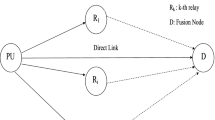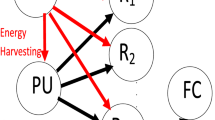Abstract
In this paper, we evaluate the detection and false alarm probabilities for relay based spectrum sensing techniques using the energy detector. The communication process consists of two phases. In the first phase, the primary user P transmits and K relays listen. In the second phase, the relays amplify the signal to the fusion center where spectrum sensing based on the energy detector is performed. All relays transmit over orthogonal channels. We also consider cooperative spectrum sensing with best relay selection. Both opportunistic amplify and forward, partial and reactive relay selection are considered. The results are valid for Rayleigh fading channels in the absence or presence of a direct link between P and the fusion center D.






Similar content being viewed by others
References
FCC. (2002). Spectrum policy task force. Technical report.
Haykin, S. (2005). Cognitive radio: Brain-empowered wireless communications. IEEE Journal on Selected Areas in Communications, 23, 201–220.
Digham, F. F., Alouini, M. S., & Simon, M. K. (2007). On the energy detection of unknown signals over fading channels. IEEE Transactions on Communications, 55(1), 21–24.
Bhargavi, D., & Murthy, C. R. (2010). Performance comparison of energy, matched-filter and cyclostationarity-based spectrum sensing. In SPAWC.
Man, L., Li, Y., & Demir, A. (2012). Matched filtering assisted energy detection for sensing weak primary user signals. In IEEE ICASSP.
Atapattu, S., Tellambura, C., & Jiang, H. (2009). Relay based cooperative spectrum sensing in cognitive radio networks. In GLOBECOM.
Atapattu, S., Tellambura, C., & Jiang, H. (2011). Energy detection based cooperative spectrum sensing in cognitive radio networks. IEEE Transactions on Wireless Communications, 4(10), 1232–1241.
Akyildiz, I. F., Lo, B. F., & Balakrishnan, R. (2011). Cooperative spectrum sensing in cognitive radio networks: A survey. Physical Communication, 4, 40–62.
Ghasemi, A., & Sousa, E. (2005). Collaborative spectrum sensing for opportunistic access in fading environments. In Proceedings of IEEE DySPAN (pp. 131–136).
Visotsky, E., Kuffner, S., & Peterson, R. (2005). On collaborative detection of TV transmissions in support of dynamic spectrum sharing. In Proceedings of IEEE DySPAN (pp. 338–245).
Unnikrishnan, J., & Veeravalli, V. V. (2008). Cooperative sensing for primary detection in cognitive radio. IEEE Journal on Selected Topics in Signal Processing, 21, 18–27.
Li, Z., Yu, F., & Huang, M. (2009). A cooperative spectrum sensing consensus scheme in cognitive radio. In Proceedings of INFOCOM (pp. 2546–2550).
Ganesa, G., & Li, Y. G. (2007). Cooperative spectrum sensing in cognitive radio, part I: Two user networks. IEEE Transactions on Wireless Communications, 6, 2204–2213.
Ganesa, G., & Li, Y. G. (2007). Cooperative spectrum sensing in cognitive radio, part II: Multiuser networks. IEEE Transactions on Wireless Communications, 6, 2204–2213.
Zhang, W., & Letaief, K. (2008). Cooperative spectrum sensing with transmit and relay diversity in cognitive radio networks. IEEE Transactions on Wireless Communications, 7(12), 4761–4766.
Alhamad, R., Wang, H., & Yao, Y.-D. (2017). Cooperative spectrum sensing with random access reporting channels in cognitive radio networks. IEEE Transactions on Vehicular Technology, 99, 1–13.
Caso, G., De Nardis, L., Ferrante, G. C., & Di Benedetto, M. G. (2013). Cooperative spectrum sensing based on majority decision under CFAR and CDR constraints. In IEEE PIMRC.
Ma, J., Zhao, G., & Li, Y. (2008). Soft combination and detection for cooperative spectrum sensing in cognitive radio networks. IEEE Transactions on Wireless Communications, 7(11), 4502–4507.
Ejaz, W., Hattab, G., Cherif, N., Ibnkahla, M., Abdelkefi, F., & Siala, M. (2017). Cooperative spectrum sensing with heterogeneous devices: Hard combining versus soft combining. IEEE Systems Journal, 99, 1–12.
Guo, H., Reisi, N., Jiang, W., & Luo, W. (2017). Soft combination for cooperative spectrum sensing in fading channels. IEEE Access, 5, 975–986.
Guo, H., Jiang, W., & Luo, W. (2017). Linear soft combination for cooperative spectrum sensing in cognitive radio networks. IEEE Communications Letters, 21(7), 1573–1576.
Hwang, I., & Lee, J. W. (2017). Cooperative spectrum sensing with quantization combining over imperfect feedback channels. IEEE Transactions on Signal Processing, 65(3), 721–732.
Quoc Bao, V. N., Duong, T. Q., da Costa, D. B., Alexandropoulos, G. C., & Nallanathan, A. (2013). Cognitive amplify-and-forward relaying with best relay selection in non-identical Rayleigh fading. IEEE Communications Letters, 17(3), 475–478.
Michalopoulos, D. S., & Karagiannidis, G. K. (2008). Performance analysis of single relay selection in Rayleigh fading. IEEE Transactions on Wireless Communications, 7(10), 3718–3724.
Suraweera, H. A., Smith, P. J., & Shafi, M. (2010). Capacity limits and performance analysis of cognitive radio with imperfect channel knowledge. IEEE Transactions on Vehicular Technology, 59(4), 1811–1822.
Zhao, Y., Adve, R., & Lim, T. J. (2006). Symbol error rate of selection amplify and forward relay systems. IEEE Communications Letters, 10, 757–759.
Ikki, S. S., & Ahmed, M. H. (2008). Performance of multiple-relay cooperative diversity systems with best relay selection over Rayleigh fading channels. EURASIP Journal on Advances in Signal Processing, 17, 145.
Barua, B., Ngo, H. Q., & Shin, H. (2008). On the SEP of cooperative diversity with opportunistic relaying. IEEE Communications Letters, 12(10), 727–729.
Krikidis, I., Thompson, J., McLaughlin, S., & Goertz, N. (2008). Amplify and for-ward with partial relay selection. IEEE Communications Letters, 12(4), 237–238.
Boujemaa, H. (2010). Exact symbol error probability of cooperative systems with partial relay selection. European Transactions on Telecommunications, 21, 79–85.
Hussain, S. I., Alouini, M. S., Qaraqe, K., & Hasna, M. (2012). Reactive relay selection in underlay cognitive networks with fixed gain relays. In IEEE ICC.
Digham, F. F., Alouini, M. S., & Simon, M. K. (2003) On the energy detection of unknown signals over fading channels. In Proceedings of IEEE ICC conference (pp. 3575–3579).
Proakis, J. G. (1995). Digital communications (3rd ed.). New York: McGraw Hill.
Hasna, M., & Alouini, M. S. (2003). End-to-end performance of transmission systems with relays over Rayleigh fading channels. IEEE Transactions on Wireless Communications, 2, 1126–1131.
Acknowledgements
The sincere appreciation for the deanship of Scientific research at Saudi Electronic University for funding this research.
Author information
Authors and Affiliations
Corresponding author
Ethics declarations
Conflict of interest
On behalf of all authors, the corresponding author states that there is no conflict of interest.
Appendix A
Appendix A
The Cumulative Distribution Function (CDF) of \(\Gamma _{k}^{up}\) is equal to
We have
where \((a_{n}(1),\ldots ,a_{n}(K))\) is the binary representation of n and \( b(n)=\sum _{l=1}^{K}a_{n}(l).\)
Using (52) and (53), we deduce
By a simple derivative, we deduce the PDF of \(\Gamma _{k}^{up}\):
where
Rights and permissions
About this article
Cite this article
Alhamad, R., Boujemaa, H. Cooperative spectrum sensing with relay selection. Telecommun Syst 68, 631–642 (2018). https://doi.org/10.1007/s11235-017-0413-1
Published:
Issue Date:
DOI: https://doi.org/10.1007/s11235-017-0413-1




